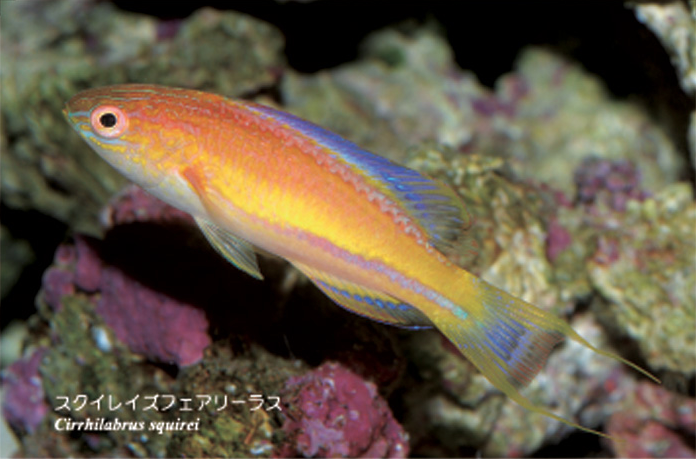BlueHarbor, whose shop is now flooded with rare fish from the Southern Pacific, is also home to two rare fairy wrasses from the Coral Sea. This is the newest member of the highly perplexing “lunatus” species complex that is also found furthest away from the others in the Australian region. Koji received a single male back in June 2012 pictured above, and we were fortunate enough to witness the beauty in person during our trip to BlueHarbor.
This is the second time Koji has acquired this fairy wrasse, named after Cairns Marine’s Lyle Squire. The first piece whose pictures and videos have been well taken, including the October BlueHarbor calendar picture featured above, has been sold to Koji’s customer who has an incredible collection of deepwater fish.

As mentioned above, C. “squirei” is a brand new member of the confusing group featuring similarly sized and colored fairy wrasses. While not an officially described member to the Cirrhilabrus genus, C. squirei is different enough and its completely isolated range of the Coral Sea puts enough of a gap between the indo-pacific members. Apart from its very yellow unpaired fins, the body pattern is practically the same as the other members.
Excluding C. squirei, there are five other similar look a likes. The Marshall Island endemic C. johnsoni, the undescribed Cirrhilabrus cf. lanceolatus a.k.a the pintail fairy wrasse, C. brunneus, C. lunatus and the Philippine version of C. lunatus with a distinct color form that could potentially be separated as a valid species. This Philippine version of C. lunatus lacks the broad yellow band found in the Japanese forms.
To make things a little more confusing, C. lunatus can and has on many occasions, hybridise with the undescribed Cirrhilabrus cf. lanceolatus (pintail fairy wrasse), in Japan (Pic. B). Although the pintail fairy wrasse lacks an obvious crescent tail but instead possesses a lanceolated tail, its ability to hybridise with C. lunatus means that they are more closely related than they appear. Its body markings are also very similar to C. lunatus.
With that in mind, the real identity of C. squirei leaves many questions unanswered. Like C. johnsoni, it is also the least similar to the three in the indo-pacific – japan reagion. It is quite likely that C. squirei originated as an isolated population of C. lunatus that evolved over hundreds of years into its distinct Coral Sea form. We’re no scientists but we do hope some information regarding its similarities to C. lunatus will be revealed eventually in its official description papers.



